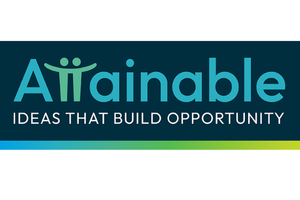Intermediaries Are Key to Building Education-to-Career Pathways That Work
Catalysts for Connection: The Critical Role of Intermediaries in Education-to-Career Pathways

For years, people have asked us some version of the same question: “So… what exactly is The Attainment Network?”
It’s a fair question. We’re not part of a school district, and we don’t just work with colleges and universities. We’re not an apprenticeship organization or connected to any employer or specific industry.
We don’t fit neatly into any one lane—because our job is to make sure the whole education-to-career journey is coordinated.
The Attainment Network is an intermediary, and let’s admit it: the term intermediary—can feel a little… squishy. Like a middle layer—hard to define but somehow essential. We’ve even joked about it ourselves. Over time, though, we’ve come to see ourselves in this word. While the term may sound a little squishy, the work is anything but. The Attainment Network and other intermediaries play a critical and concrete role in making education-to-career systems work for learners.
For too long, our high schools, higher education institutions, and employers have been operating in isolation, each within their own silos. This disjointed system no longer meets the needs of learners or our employers. Students and families know it. Nearly three-quarters of high school students say they want a career plan in place by graduation (ECMC Question the Quo Survey, 2022), and 81% say learning the skills they need to succeed is an important factor in their postsecondary decisions.
Cross-sector collaboration is essential, but it’s hard. Stakeholders often speak different languages, frame goals differently, and approach their work from varying perspectives. Yet everyone shares a common commitment to serving learners and strengthening communities. Still, without consistent leadership, practical structure, and dedication to shared problem-solving, career pathways that bridge high school, postsecondary, and the workforce are nearly impossible to build and sustain.
This is where intermediaries step in.
Intermediary: Not So Squishy After All
In plain terms, an intermediary provides the glue that holds complex partnerships together. At our best, intermediaries bring deep ecosystem knowledge, access to resources, and expertise in diplomacy to help diverse partners define and work toward shared goals.
We often describe the intermediary role with a mix of metaphors because it’s many things at once. An intermediary is part project manager and part subject matter expert; part stage manager who stays behind the curtain so others can shine; part kindergarten teacher helping everyone in the sandbox learn to share; part “critical friend” who offers tough love; and part cheerleader who lifts up success and keeps momentum going.
We do far more than manage logistics. We help shape a common vision, build local capacity, and ensure equity is embedded at every step. We build the trust needed among partners who may sometimes feel like competitors—creating the conditions to share data, align quality standards and measures of success, and show up consistently.
More specifically, an intermediary keeps systems moving forward by:
- Convening diverse partners across sectors to co-design pathways and drive collective action.
- Enabling collaboration by creating the structures and supports that allow educators, employers, and community partners to focus on a shared vision.
- Operationalizing complex ideas, especially in the data sphere, by translating statewide frameworks and metrics into practical, usable tools that help communities align and measure progress.
- Securing and aligning funding, helping to braid and direct resources that fuel innovation and sustain impact.
- Advocating for career-connected pathways as rigorous, relevant, and equitable options, shifting narratives and influencing policy and practice.
Bottom line: intermediaries live by the idea that we are better together—more effective, more efficient, more impactful, more aligned, and more able to deliver on the shared goals of the people and communities we serve.
The Attainment Network is one such intermediary, with proven experience supporting Colorado communities. We don’t arrive with pre-packaged solutions. Instead, we meet communities where they are, drawing from best and promising practices, connecting local efforts to state-level feedback loops, and keeping learner and community voice at the center. This systems-change orientation is core to who we are.
The Secret Sauce in the San Luis Valley Career-Connected Partnership
The power of the intermediary role comes alive in places like Colorado’s San Luis Valley (SLV). Through the SLV Career-Connected Partnership—made up of more than two dozen active partners—we’ve joined local school districts, higher education institutions, employers, and nonprofits to develop a shared vision and goals for career-connected learning and to execute the action plan that turns that vision into reality.
Together, we’re not only co-creating strategy but also supporting on-the-ground implementation: adapting to local needs while building partner capacity, keeping equity at the forefront, providing consistency through transitions, and strengthening employer engagement strategies. This work is creating a sustainable nursing pipeline to meet local needs, with the next step being expansion and replication in other industries.
The Attainment Network’s Unique Role in Colorado
The Attainment Network plays a unique role in Colorado’s education-to-workforce ecosystem, working at the intersection of implementation and policy to bring about real systems change. We help communities design and deliver high-quality, equity-focused solutions that meet their workforce needs while elevating the work to policymakers to inform efforts to scale effective models.
- We know that lasting change happens only when the full education-to-career system is aligned, so we bring K-12, higher education, employers, and community organizations to the table. We build activated partnerships and nurture the collaboration needed to align complex systems and achieve measurable results.
- We don’t bring pre-packaged solutions to our partners. We start at the beginning by identifying the strengths, resources, and knowledge already present in the community. Only then do we provide tailored coaching, technical assistance, and resources to build their capacity to strengthen their own systems.
- Our trusted relationships with both state and local policymakers enable us to serve as a translator—helping communities understand policy shifts while elevating the work to state leaders so they can see how their policies play out in practice.
- Because all of this work is emergent, we know that approaching it through a learning lens is essential. There simply is no established playbook for constructing and sustaining a career-connected learning ecosystem. We work to identify learnings, codify best practices and share out among partners.
In rural Colorado, for example, we’re working alongside our partners to pinpoint workforce needs and identify additional intermediaries with subject matter expertise in industries like construction and skilled trades. We’re demonstrating how intermediaries help communities reach more learners and expand proven models to new geographies and new industries.
We’re also leaning into emerging fields like quantum. Our unique approach is informing the communications strategy for the implementation of Colorado’s quantum career pathways. We are synthesizing insights from educators, learners, employers, state leaders, private sector partners, and both rural and urban communities to create a strategic communications plan for the regional initiative spanning Colorado, New Mexico, and Arizona.
We’re also evolving our work to focus on career advising and navigation to support the high-quality implementation of the “Big 3” (concurrent enrollment, industry-recognized credentials, and work-based learning) to ensure the success of all the state’s work on career-connected pathways. And we’re partnering with other intermediaries to provide insights into the state’s longitudinal data system to ensure its effectiveness.
Call to Action
There are real challenges in our field: thin capacity, confusion about the need for and value of intermediaries, an increasingly crowded intermediary space, heavy reliance on short-term philanthropy, and no infrastructure for sharing tools, data, and best practices.
But here’s what we believe: intermediaries sit at a unique vantage point in the education-to-workforce ecosystem. The challenges of unstable funding, fragmented data, uneven employer engagement, and shifting policy landscapes also serve as openings for innovation, alignment, and leadership. By clarifying our value, deepening partnerships, and centering equity, intermediaries can move from being perceived as only a “middle layer” to being recognized as essential catalysts for systems change and lasting impact.
Now is the time to maximize these critical functions, deepen our collaboration—both among institutions that connect to intermediaries and between intermediaries —and deliver on the promise of education and training systems that truly provide economic prosperity for all.
When systems connect, learners thrive. Intermediaries make that connection possible.
Written by Rana Tarkenton, CEO, and Andrea Stiles Pullas, Board Chair of The Attainment Network.
RECENT ARTICLES



